Ning Hu
Pre-train and Fine-tune: Recommenders as Large Models
Jan 24, 2025



Abstract:In reality, users have different interests in different periods, regions, scenes, etc. Such changes in interest are so drastic that they are difficult to be captured by recommenders. Existing multi-domain learning can alleviate this problem. However, the structure of the industrial recommendation system is complex, the amount of data is huge, and the training cost is extremely high, so it is difficult to modify the structure of the industrial recommender and re-train it. To fill this gap, we consider recommenders as large pre-trained models and fine-tune them. We first propose the theory of the information bottleneck for fine-tuning and present an explanation for the fine-tuning technique in recommenders. To tailor for recommendation, we design an information-aware adaptive kernel (IAK) technique to fine-tune the pre-trained recommender. Specifically, we define fine-tuning as two phases: knowledge compression and knowledge matching and let the training stage of IAK explicitly approximate these two phases. Our proposed approach designed from the essence of fine-tuning is well interpretable. Extensive online and offline experiments show the superiority of our proposed method. Besides, we also share unique and important lessons we learned when deploying the method in a large-scale online platform. We also present the potential issues of fine-tuning techniques in recommendation systems and the corresponding solutions. The recommender with IAK technique has been deployed on the homepage of a billion-scale online food platform for several months and has yielded considerable profits in our business.
CSPM: A Contrastive Spatiotemporal Preference Model for CTR Prediction in On-Demand Food Delivery Services
Aug 10, 2023Abstract:Click-through rate (CTR) prediction is a crucial task in the context of an online on-demand food delivery (OFD) platform for precisely estimating the probability of a user clicking on food items. Unlike universal e-commerce platforms such as Taobao and Amazon, user behaviors and interests on the OFD platform are more location and time-sensitive due to limited delivery ranges and regional commodity supplies. However, existing CTR prediction algorithms in OFD scenarios concentrate on capturing interest from historical behavior sequences, which fails to effectively model the complex spatiotemporal information within features, leading to poor performance. To address this challenge, this paper introduces the Contrastive Sres under different search states using three modules: contrastive spatiotemporal representation learning (CSRL), spatiotemporal preference extractor (StPE), and spatiotemporal information filter (StIF). CSRL utilizes a contrastive learning framework to generate a spatiotemporal activation representation (SAR) for the search action. StPE employs SAR to activate users' diverse preferences related to location and time from the historical behavior sequence field, using a multi-head attention mechanism. StIF incorporates SAR into a gating network to automatically capture important features with latent spatiotemporal effects. Extensive experiments conducted on two large-scale industrial datasets demonstrate the state-of-the-art performance of CSPM. Notably, CSPM has been successfully deployed in Alibaba's online OFD platform Ele.me, resulting in a significant 0.88% lift in CTR, which has substantial business implications.
Mobile Supply: The Last Piece of Jigsaw of Recommender System
Aug 09, 2023Abstract:Recommendation system is a fundamental functionality of online platforms. With the development of computing power of mobile phones, some researchers have deployed recommendation algorithms on users' mobile devices to address the problems of data transmission delay and pagination trigger mechanism. However, the existing edge-side mobile rankings cannot completely solve the problem of pagination trigger mechanism. The mobile ranking can only sort the items on the current page, and the fixed set of candidate items limits the performance of the mobile ranking. Besides, after the user has viewed the items of interest to the user on the current page, the user refresh to get a new page of items. This will affect the user's immersive experience because the user is not satisfied with the left items on the current page. In order to address the problem of pagination trigger mechanism, we propose a completely new module in the pipeline of recommender system named Mobile Supply. The pipeline of recommender system is extended to "retrival->pre-ranking->ranking->re-ranking->Mobile Supply->mobile ranking". Specifically, we introduce the concept of list value and use point-wise paradigm to approximate list-wise estimation to calculate the maximum revenue that can be achieved by mobile ranking for the current page. We also design a new mobile ranking approach named device-aware mobile ranking considering the differences of mobile devices tailored to the new pipeline. Extensive offline and online experiments show the superiority of our proposed method and prove that Mobile Supply can further improve the performance of edge-side recommender system and user experience. Mobile Supply has been deployed on the homepage of a large-scale online food platform and has yielded considerable profits in our business.
Exploring the Spatiotemporal Features of Online Food Recommendation Service
Aug 08, 2023Abstract:Online Food Recommendation Service (OFRS) has remarkable spatiotemporal characteristics and the advantage of being able to conveniently satisfy users' needs in a timely manner. There have been a variety of studies that have begun to explore its spatiotemporal properties, but a comprehensive and in-depth analysis of the OFRS spatiotemporal features is yet to be conducted. Therefore, this paper studies the OFRS based on three questions: how spatiotemporal features play a role; why self-attention cannot be used to model the spatiotemporal sequences of OFRS; and how to combine spatiotemporal features to improve the efficiency of OFRS. Firstly, through experimental analysis, we systemically extracted the spatiotemporal features of OFRS, identified the most valuable features and designed an effective combination method. Secondly, we conducted a detailed analysis of the spatiotemporal sequences, which revealed the shortcomings of self-attention in OFRS, and proposed a more optimized spatiotemporal sequence method for replacing self-attention. In addition, we also designed a Dynamic Context Adaptation Model to further improve the efficiency and performance of OFRS. Through the offline experiments on two large datasets and online experiments for a week, the feasibility and superiority of our model were proven.
Multi-Granularity Attention Model for Group Recommendation
Aug 08, 2023Abstract:Group recommendation provides personalized recommendations to a group of users based on their shared interests, preferences, and characteristics. Current studies have explored different methods for integrating individual preferences and making collective decisions that benefit the group as a whole. However, most of them heavily rely on users with rich behavior and ignore latent preferences of users with relatively sparse behavior, leading to insufficient learning of individual interests. To address this challenge, we present the Multi-Granularity Attention Model (MGAM), a novel approach that utilizes multiple levels of granularity (i.e., subsets, groups, and supersets) to uncover group members' latent preferences and mitigate recommendation noise. Specially, we propose a Subset Preference Extraction module that enhances the representation of users' latent subset-level preferences by incorporating their previous interactions with items and utilizing a hierarchical mechanism. Additionally, our method introduces a Group Preference Extraction module and a Superset Preference Extraction module, which explore users' latent preferences on two levels: the group-level, which maintains users' original preferences, and the superset-level, which includes group-group exterior information. By incorporating the subset-level embedding, group-level embedding, and superset-level embedding, our proposed method effectively reduces group recommendation noise across multiple granularities and comprehensively learns individual interests. Extensive offline and online experiments have demonstrated the superiority of our method in terms of performance.
ESMC: Entire Space Multi-Task Model for Post-Click Conversion Rate via Parameter Constraint
Jul 29, 2023Abstract:Large-scale online recommender system spreads all over the Internet being in charge of two basic tasks: Click-Through Rate (CTR) and Post-Click Conversion Rate (CVR) estimations. However, traditional CVR estimators suffer from well-known Sample Selection Bias and Data Sparsity issues. Entire space models were proposed to address the two issues via tracing the decision-making path of "exposure_click_purchase". Further, some researchers observed that there are purchase-related behaviors between click and purchase, which can better draw the user's decision-making intention and improve the recommendation performance. Thus, the decision-making path has been extended to "exposure_click_in-shop action_purchase" and can be modeled with conditional probability approach. Nevertheless, we observe that the chain rule of conditional probability does not always hold. We report Probability Space Confusion (PSC) issue and give a derivation of difference between ground-truth and estimation mathematically. We propose a novel Entire Space Multi-Task Model for Post-Click Conversion Rate via Parameter Constraint (ESMC) and two alternatives: Entire Space Multi-Task Model with Siamese Network (ESMS) and Entire Space Multi-Task Model in Global Domain (ESMG) to address the PSC issue. Specifically, we handle "exposure_click_in-shop action" and "in-shop action_purchase" separately in the light of characteristics of in-shop action. The first path is still treated with conditional probability while the second one is treated with parameter constraint strategy. Experiments on both offline and online environments in a large-scale recommendation system illustrate the superiority of our proposed methods over state-of-the-art models. The real-world datasets will be released.
BASM: A Bottom-up Adaptive Spatiotemporal Model for Online Food Ordering Service
Nov 22, 2022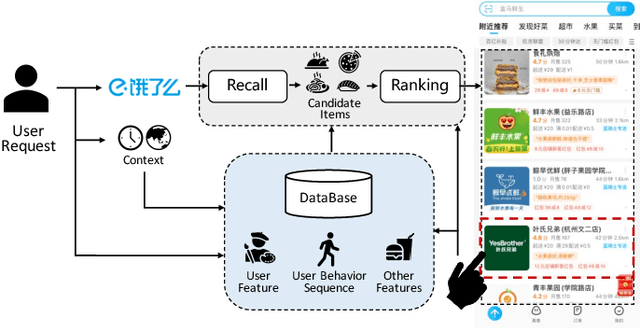
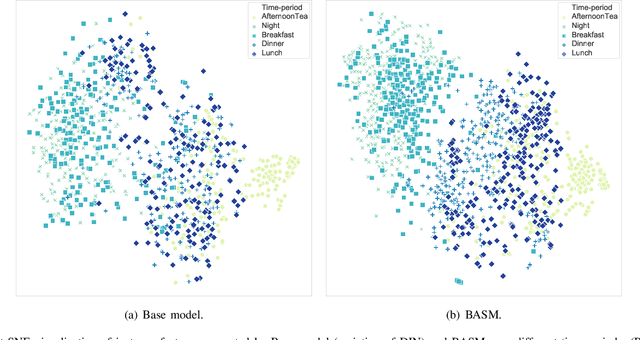
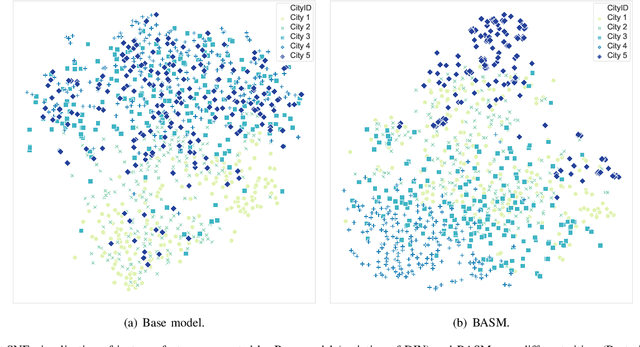
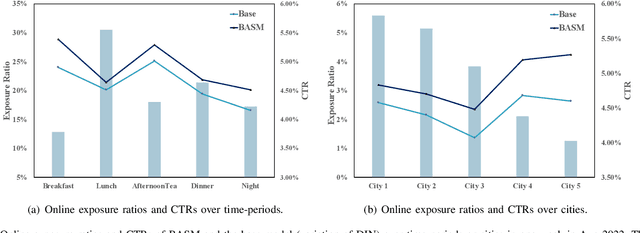
Abstract:Online Food Ordering Service (OFOS) is a popular location-based service that helps people to order what you want. Compared with traditional e-commerce recommendation systems, users' interests may be diverse under different spatiotemporal contexts, leading to various spatiotemporal data distribution, which limits the fitting capacity of the model. However, numerous current works simply mix all samples to train a set of model parameters, which makes it difficult to capture the diversity in different spatiotemporal contexts. Therefore, we address this challenge by proposing a Bottom-up Adaptive Spatiotemporal Model(BASM) to adaptively fit the spatiotemporal data distribution, which further improve the fitting capability of the model. Specifically, a spatiotemporal-aware embedding layer performs weight adaptation on field granularity in feature embedding, to achieve the purpose of dynamically perceiving spatiotemporal contexts. Meanwhile, we propose a spatiotemporal semantic transformation layer to explicitly convert the concatenated input of the raw semantic to spatiotemporal semantic, which can further enhance the semantic representation under different spatiotemporal contexts. Furthermore, we introduce a novel spatiotemporal adaptive bias tower to capture diverse spatiotemporal bias, reducing the difficulty to model spatiotemporal distinction. To further verify the effectiveness of BASM, we also novelly propose two new metrics, Time-period-wise AUC (TAUC) and City-wise AUC (CAUC). Extensive offline evaluations on public and industrial datasets are conducted to demonstrate the effectiveness of our proposed modle. The online A/B experiment also further illustrates the practicability of the model online service. This proposed method has now been implemented on the Ele.me, a major online food ordering platform in China, serving more than 100 million online users.
Spatiotemporal-Enhanced Network for Click-Through Rate Prediction in Location-based Services
Sep 20, 2022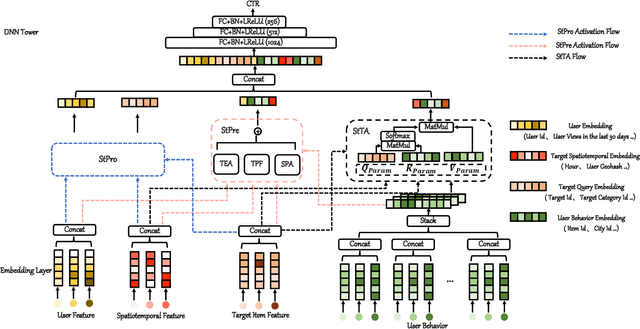
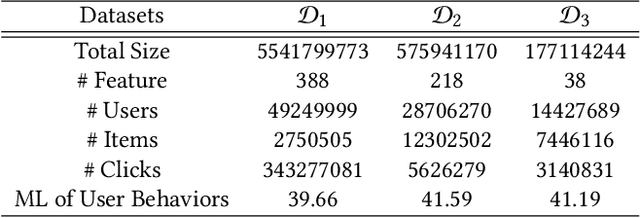
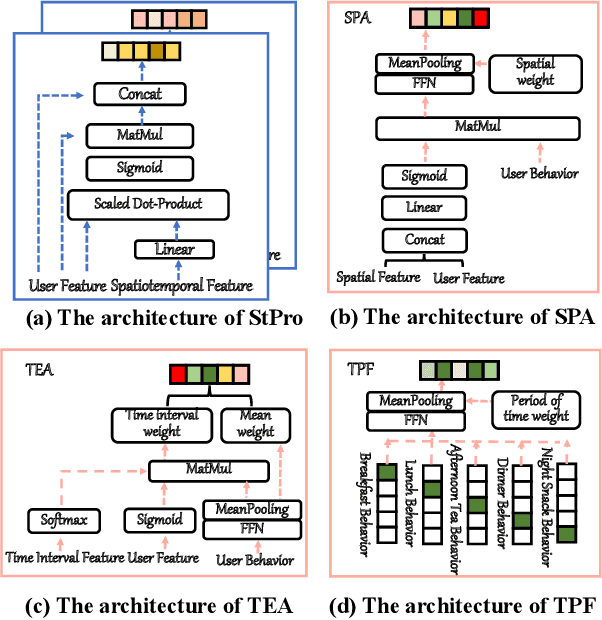
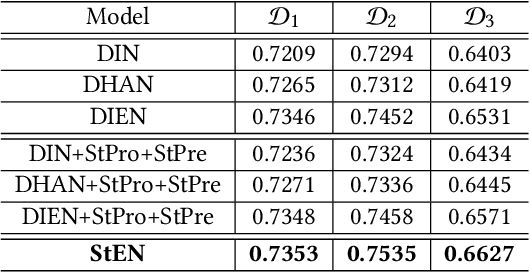
Abstract:In Location-Based Services(LBS), user behavior naturally has a strong dependence on the spatiotemporal information, i.e., in different geographical locations and at different times, user click behavior will change significantly. Appropriate spatiotemporal enhancement modeling of user click behavior and large-scale sparse attributes is key to building an LBS model. Although most of existing methods have been proved to be effective, they are difficult to apply to takeaway scenarios due to insufficient modeling of spatiotemporal information. In this paper, we address this challenge by seeking to explicitly model the timing and locations of interactions and proposing a Spatiotemporal-Enhanced Network, namely StEN. In particular, StEN applies a Spatiotemporal Profile Activation module to capture common spatiotemporal preference through attribute features. A Spatiotemporal Preference Activation is further applied to model the personalized spatiotemporal preference embodied by behaviors in detail. Moreover, a Spatiotemporal-aware Target Attention mechanism is adopted to generate different parameters for target attention at different locations and times, thereby improving the personalized spatiotemporal awareness of the model.Comprehensive experiments are conducted on three large-scale industrial datasets, and the results demonstrate the state-of-the-art performance of our methods. In addition, we have also released an industrial dataset for takeaway industry to make up for the lack of public datasets in this community.
 Add to Chrome
Add to Chrome Add to Firefox
Add to Firefox Add to Edge
Add to Edge